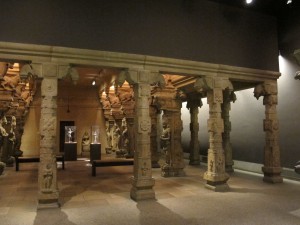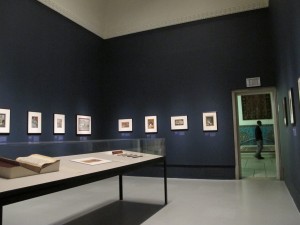Art, history, and interpretation
28 June 2013 – Mekala Krishnan
I recently started a new position at the Philadelphia Museum of Art as a Curatorial and Interpretation Fellow, for which my Public History degree from American University has been (and will continue to be) invaluable. Understanding art through history and vice versa is one of the joys of curatorial work in an art museum, but interpreting cultural, historical, religious and aesthetic context to a wider audience can be a real challenge. This is especially true when one focuses on art from a culture that is foreign to a large number of American museum visitors. My work involves the PMA’s South Asian art collection, which is currently undergoing a process of reinterpretation and reinstallation and will be re-presented to the public in 2015. My position as point person in the reinstallation involves working with both the curatorial and education departments to understand visitors’ entry points on to the subject of South Asian history, art, culture, religion and philosophy, and to come up with thoughtful and innovative ways to activate a stellar collection of artworks and allow it to speak across cultural borders.
While my academic training in Indian history and art history, and my three years of work experience as a research assistant at Smithsonian’s Freer and Sackler Galleries are all integral to this position, the principles of interpretation and making complex subject matter accessible and engaging to a wide audience are at the core of this reinstallation. Curators at art museums regularly translate the incredibly in-depth research they conduct into brief wall labels and catalog entries, easily digestible nuggets of the most essential information. This reinstallation is about taking that to another level–how can we make a subject that is generally foreign and complex less intimidating and more exciting to a diverse audience? And how can we do so in a way that is fresh and modern for the museum setting? How can we incorporate technology in a way that enhances but does not overshadow the art? At the end of the day, the aim is to get viewers to look more closely, make discoveries, and appreciate beauty and technique. Hopefully during this process they also learn something about a culture that spans across an entire subcontinent, thousands of years, and multiple religions, languages, empires and ethnic groups!
Starting with undertaking visitor surveys and tracking studies to see how visitors interact with the current galleries and artworks on display, we are looking to create interpretation that best speaks to the museum’s target audiences. From there we will boil down themes and narrative content in a way that creates connections between history and living traditions, between the sacred and secular, between art and everyday functional objects, so that visitors can find something to relate to in what they see. We will think about different methods of delivering this content: wall labels, audio tours, interactive kiosks and video labels with access to information on the art making process, or the museum collection and conservation processes, programming that brings related performing arts into the galleries to enhance the visual art, etc. We will redesign the space so that connections are more physically apparent, and aesthetic beauty can be more fully appreciated. And we will reach out to target heritage communities so that their perspectives and histories can be incorporated and vocalized in the galleries as well. The culmination of this process will be a reinvigorating look at the museum’s permanent collection of South Asian art.
The study of public history has allowed me to understand and be prepared for each of these steps, and to really relish the thought of making all of these masterpieces more available and interesting to the public. I want audiences to have a taste of the passion and appreciation I feel for these brilliant artworks, for their fascinating and important history, and for the diverse and rich culture from which they emerged. Over the next few months, I will be involved in visitor surveying and tracking studies, digital interpretive content development, community outreach through focus groups, and research on specific artworks in the collections–all of which I hope to share in subsequent posts. As with so much public history work, I want to help bring the past to life to demonstrate its constant impact on the present.
~ Mekala Krishnan is the E. Rhodes and Leona B. Carpenter Foundation Fellow in Indian and Himalayan Art at the Philadelphia Museum of Art.






Since I was a kid, this has long been one of my favorite rooms in the Philly Musieum of Art. Walking thru this wing of the building always gave me the feeling I was visiting another country. and this room was the most extreme example of it.
It’s like stepping into the film “Marco The Magnificent”, and only a half-hour from my house.